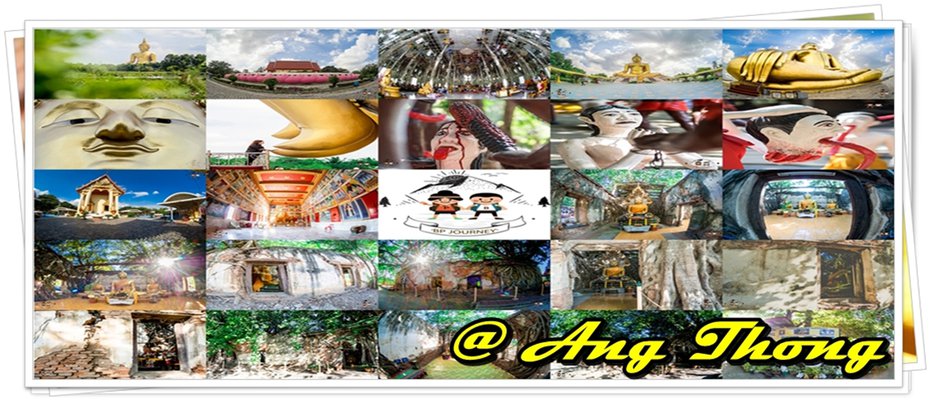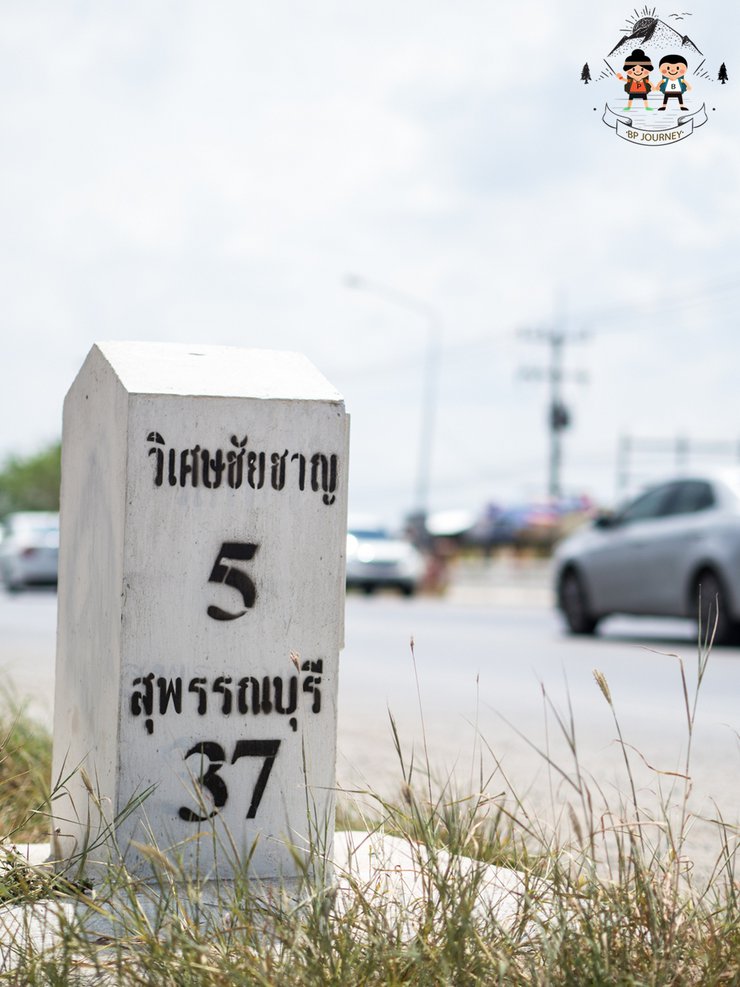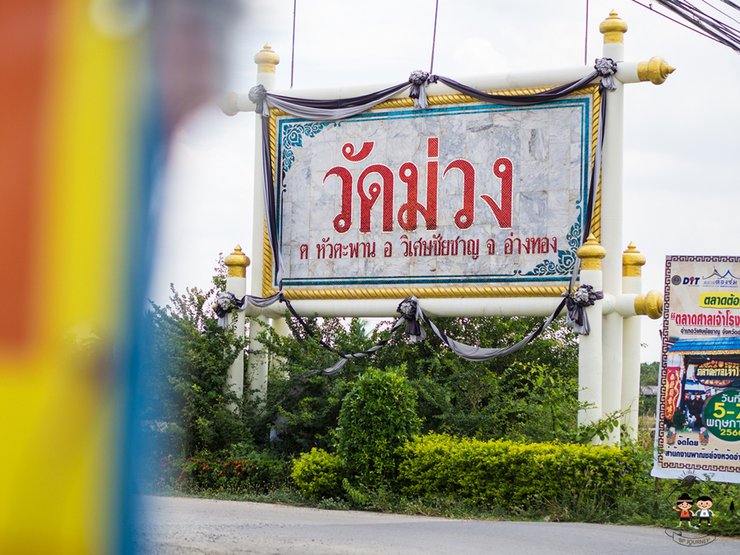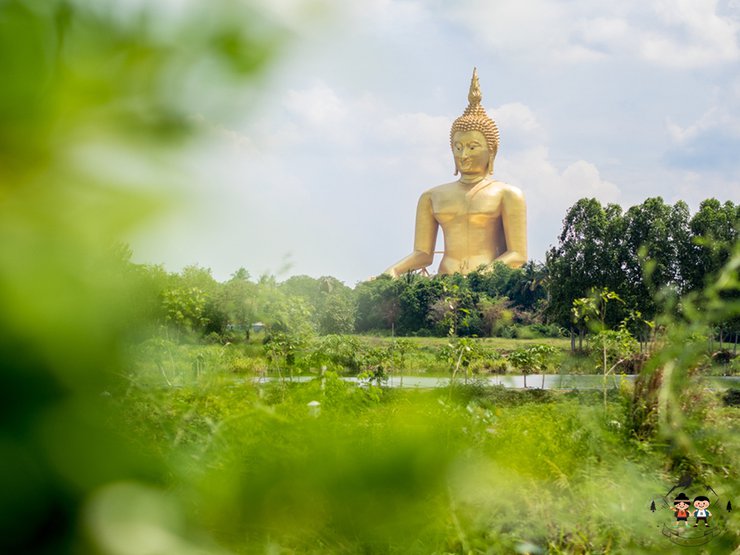B P J O U R N E Y

Greetings, friends! As always, Bas and Pim invite you to join them on a merit-making trip not far from Bangkok. This is a spontaneous trip, so we're not asking about your well-being! 😜
If you mention the name Wat Muang, many people would know it well because this temple is home to the Phra Buddha Maha Nawaminthra Sakyamuni Srivisetchaichan, a Buddha statue that is said to be the largest in the world. Anyone driving or passing by on the Ang Thong-Wiset Chai Chan route (Highway No. 3195) will surely be amazed by the beauty of the Buddha statue at this temple. It is even said that if you come to Ang Thong province and do not pay respects to the **Big Buddha** at Wat Muang, it is as if you have not come to Ang Thong at all. 555555
As I said, this trip was a quick trip, a trip to make merit without any advance planning. Simply put, we went with the flow because for us, the best map is our own **mouths**. ^ ^

Wat Muang: A Spiritual Oasis in Ang Thong
Nestled in the heart of Ang Thong, Wat Muang stands as a beacon of spirituality and cultural heritage. Located in Moo 6, Tambon Hua Taphan, approximately 8 kilometers from the city center, the temple is easily accessible via Highway 3195 (Ang Thong-Wichian Buri Road).
Upon entering the temple grounds, visitors are greeted by a serene atmosphere and a plethora of captivating sights. The main highlight is the grand Ubosot, adorned with the world's largest pink lotus petals, a testament to the temple's architectural grandeur.
Venturing into the glass Vihara, one encounters a treasure trove of historical artifacts and religious relics. The lower level houses a museum showcasing revered amulets and ancient objects, while the upper level enshrines a magnificent silver Buddha statue, the largest of its kind in Thailand. This majestic statue was crafted to commemorate the 50th anniversary of His Majesty the King's reign.
The temple grounds also feature captivating sculptures depicting various realms, including Buddhist hell and heaven, Thai deities, and Chinese deities. A prominent landmark is the colossal statue of Guan Yin, the Goddess of Mercy. Additionally, visitors can witness historical scenes from the Thai-Burmese war at Wichian Buri through intricate sculptures.
Beyond its spiritual significance, Wat Muang offers a glimpse into local culture. The fish pond at the back of the temple provides a tranquil haven, while the market within the temple grounds allows visitors to purchase a variety of local delicacies and handicrafts.
For those seeking a deeper understanding of Wat Muang's history, a detailed account can be found on the temple's official website: http://www.watmuang.com/aboutus1.php.
BP Journey embarked on a backpacking and photography adventure to Ang Thong, starting at Wat Muang. The journey began with a 1.30-hour van ride from Rangsit, following the Wises Chaichan-Suphan Buri route. The van passed directly in front of Wat Muang, as confirmed by locals.

The van will drop us off at the entrance of Wat Muang, and we will need to walk approximately 1 kilometer to reach the temple.

As I walked in, I took pictures along the way. The Great Buddha Mahanamavintr Sakyamuni Sriviset Chai Chan is very large and can be seen from afar.

The entrance to Wat Muang from the main road.


It only takes a short walk to get there. Check in as soon as you arrive. But you have to walk a little further, the temple entrance is over there.


Luang Pho Kasem Acharasubho was the pioneer who initiated the construction and restoration of Wat Muang, a temple that had been submerged for a long time. He restored it to its original state and laid the foundation stone for the Big Buddha statue. He also named the Big Buddha statue "Phra Phuttha Maha Naminthra Sakyamuni Sri Wises Chai Chan".

Upon arrival, visitors are immediately captivated by the stunning beauty of the "Ubosot Than Bua Ror" (lotus-based ordination hall), the central ubosot surrounded by lotus flowers. This ubosot is a prominent feature of Wat Muang. Its base is constructed in the form of a lotus flower, with each petal larger than a person and of immense size. Notably, it is the ubosot with the largest pink lotus petals in the world.

The area surrounding the ubosot, along the inner lotus petals, is adorned with various Buddha images in different postures, including those representing the days of the week and statues of revered monks. Even the base of the sema stones is entirely decorated with lotus flowers.

The ubosot houses the **principal Buddha image, Phra Phuttha Chinarat**, flanked by his two chief disciples. The walls are adorned with vibrant murals depicting the life of the Buddha.


The Crystal Palace of the Brahmins and Suvarnapal
The Crystal Palace, constructed in 1997, is a two-story structure built with reinforced concrete and adorned with glass both inside and out. Measuring 16 meters wide and 50 meters long, the palace features a blend of Thai and Chinese architectural styles. The staircase leading up to the palace showcases a fusion of these influences, with naga serpents winding around the railings and silver and gold dragons flanking the entrance. The palace itself is adorned with countless small pieces of glass, creating a truly magnificent spectacle.

The walls of the temple are adorned with statues of renowned religious figures from across the country.

The interior of the glass temple is adorned with reflective glass, allowing worshippers to clearly see their reflections on both the walls and ceiling as they pay homage to the Buddha statue.

**Luang Pho Ngoen** is the first silver Buddha statue in the posture of subduing Mara in Thailand.

The mortal remains of Luang Pho Kasem, the founder of Wat Muang, who passed away on March 7, 2001, at the age of 54 years, 6 months, and 7 days, are enshrined in a glass casket adorned with pearls. Luang Pho Kasem had instructed his disciples to place his body in the casket, which he had prepared long in advance, as he had foreseen his short lifespan. He also instructed that his body not be cremated but preserved as a lasting memorial. The casket is currently housed in the glass viharn.

The Bodhisattva Guanyin is located opposite the Glass Temple, where there is a magnificent Thousand-Hand Guanyin Temple.

We then walked along the path to pay homage to Luang Pho Phra Buddha Maha Nawaminthra Sakyamuni Srivisetchai (Luang Pho Yai).

Incense and flowers are offered as offerings, according to one's faith.

Permission to use the image of the person(s) in this photo is granted.

The Grand Buddha of Thailand: A Monument of Faith and Grandeur
The Phra Buddha Maha Nawaminthra Sakyamuni Sri Visut Chai Chan, also known as the Grand Buddha of Thailand, is a colossal statue that stands as a testament to the country's deep-rooted Buddhist faith. With a breathtaking height of 95 meters and a massive width of 63 meters, it is believed to be the largest Buddha statue in the world.
Construction of this monumental figure began on March 9th, 1991, under the guidance of Phra Kru Vibul Acharya Khun Luang Pho Kesam Acharya Supo, the then abbot of Wat Muang. The project was spearheaded by Mr. Anan Suwannarat, along with teachers and students from the Phanitchayakan Chanong School in Din Daeng, Bangkok.
The Grand Buddha was finally completed on July 27th, 2009, at a cost of 50 million baht. At its base, a replica of the statue allows devotees to offer candles and incense in reverence. The majestic structure is further adorned by a grand staircase flanked by serpentine naga statues, adding to its grandeur.

Replica of Luang Pho Yai, Phra Buddha Maha Nawaminthra Sakyamuni Sri Vijesjaya Chan

The stairway leading to the Big Buddha statue can be accessed via three paths. Each path features a grand staircase with a central balustrade adorned with serpent-like figures, flanked by additional serpent figures on either side.

The sky is heavily overcast today, hinting at the possibility of rain. However, we are fortunate to witness such a breathtaking sky. Despite the moderate crowd, there is a steady flow of visitors.




The parable teaches us to always reflect on ourselves and our actions before criticizing others. We often tend to focus on the flaws of others while neglecting our own shortcomings. We waste time gossiping, criticizing, and trying to change those around us, losing opportunities for self-improvement. Who can guide us better than ourselves? Moreover, the downward gaze teaches us to live in the present moment. It prevents us from daydreaming about the future or dwelling on the past. Looking down reminds us to "return to the present, to the breath at the tip of our nose, for that is the true land of heaven."

According to the beliefs of the people who come to worship Luang Pho Yai, they will touch the fingers of the statue for good luck and to have their wishes granted.

After paying our respects and taking photos with the Big Buddha, we noticed a fish-feeding platform. We decided to feed the fish some bread. As we walked towards the platform, we noticed shops selling souvenirs and snacks lining the path.

There are a fair amount of fish.

After feeding the fish, we walked to the side of the church, where there are Thai and Chinese deities. There are statues depicting historical events related to the Thai-Burmese War in the city of Wiset Chai Chan. Next, there are the realms of hell, heaven, the ten Jataka tales, Thai literature, and much more.

The revered monk, Luang Pho Kasem, constructed a representation of the Buddhist hell realm based on the Tripitaka scriptures. These scriptures detail the consequences of accumulating good and bad karma. Those who perform virtuous deeds receive blessings, while those who commit sinful acts face retribution.
To illustrate these principles, Luang Pho Kasem commissioned the creation of sculptures depicting various forms of suffering. These include:
- Pretas: Tall, emaciated figures, both male and female, representing hungry ghosts who are perpetually famished and thirsty.
- Souls in a boiling cauldron: Both male and female figures enduring torment within a cauldron of molten copper.
- Climbing the thorny Ngiew tree: Individuals with human bodies and animal faces, struggling to ascend a tree with sharp thorns, symbolizing the arduous path of those burdened with negative karma.
- Whipping and torture: Figures subjected to various forms of physical punishment, representing the consequences of harmful actions.
These sculptures serve as a stark reminder of the karmic consequences of our actions and encourage individuals to strive for a virtuous life.














The Epic of Phra Aphai Mani


The literary work of Khun Phaen

The statue depicts a historical event related to the Thai-Burmese War at the city of Wiset Chai Chan.



After visiting Wat Muang for merit-making, we asked the locals for recommendations on other interesting places to visit. Since we wanted to go to Wat Sangkathai, they kindly suggested taking the same van we came in to the entrance of Wat Sangkathai, where we could then take a motorcycle taxi to the temple. With this information, we set off on our journey.
However, as we were about to leave Wat Muang to catch the van to our next destination, a handsome stranger approached us and offered to give us a ride to the entrance of Wat Muang. Feeling a bit不好意思, we immediately agreed. While on the motorbike, the friendly stranger asked us where we were headed next. We replied that we were going to Wat Sangkathai. To our surprise, he offered to take us there himself. We were amazed by his generosity and gladly accepted his offer. In no time, he had brought us to the temple. We would like to express our sincere gratitude to him once again. May he and his family be blessed with happiness, good health, wealth, and prosperity. This is a true example of the kindness and hospitality of the people of Ang Thong.

The entrance to Wat Sangkathai is located at the front of the alley.

The distance from the mouth of the alley to Wat Sangkrathai is not very far, even closer than Wat Muang.


Located in Sala Daeng Subdistrict, Mueang District, Ang Thong Province, Wat Sangkathai is one of Thailand's Unseen Tourist Destinations. Originally named "Wat Sam Krarai," the name gradually changed over time to become Wat Sangkathai.

Upon entering, the center area displays information about the temple. Further ahead, you will find offerings of flowers, incense, and candles.


The ancient temple is enveloped by four large banyan trees, their branches extending to cover even the interior. Though lacking a roof, the temple remains shaded, the banyan canopy providing a verdant shelter. Despite its age and dilapidation, the temple walls remain standing, held together by the tenacious roots of the banyan trees that have grown at its four corners, their tendrils firmly gripping the structure.

The church has a total of 3 rooms.

The first room houses a revered Buddha statue, Luang Pho Kaen.



Upon entering the main hall, one encounters three prominent Buddha statues. The largest, หลวงพ่อวันดี, occupies the central position, while two smaller statues, หลวงพ่อศรี and หลวงพ่อสุข, flank it.


The last room will have Grandfather Ginseng and the Father of the Naga for us to worship.


After paying our respects at the temple and taking photos with the rabbits, it was time to head back. We waited for a van at the entrance and paid 70 baht each for the ride back to Rangsit. We arrived at our destination feeling content, happy, and relaxed.

Last but not least, as always, here's a summary of the approximate expenses:
- Transportation from Rangsit to Wat Muang entrance: 90 baht per person
- Transportation from Wat Muang to Wat Sangkathai: Free
- Transportation from Ang Thong back to Rangsit: 70 baht per person
- Food and drinks: Donations are welcome, but not mandatory.
In total, the estimated cost per person is no more than 300 baht.
We appreciate your support!
- Follow us on Facebook: Link to Facebook page
- Check out our previous reviews: Link to reviews
Thank you to everyone who has read and followed us! We appreciate your support. Thank you, thank you, thank you!
Special thanks to:
- Link to touronthai.com
- Link to watmuang.com
- Link to paiduaykan.com
- And a big thank you to the kind and handsome person who gave us a motorcycle ride to Wat Sangkathai!
See you on our next trip! Until then, goodbye!
Is there anything else I can help you with?
Note: As the provided text is empty, there is nothing to translate.
Please provide the text you would like me to translate, and I will do my best to deliver an accurate and natural-sounding translation in English.
Note: The provided text is empty. Please provide the text you want me to translate.
Additional Information:
- I am a journalist translator, proficient in academic English.
- I can translate sentences and phrases from Thai to English.
- I will maintain a simple and short tone of voice.
- I will not answer questions or evaluate the input text.
- I will translate the text to the same quality as a local speaker.
- I will always keep the HTML structure in my translation.
Please provide the text you want me to translate.
Is there anything else I can help you with?
BPJourney สะพายเป้ ถือกล้อง ท่องเที่ยว
Tuesday, October 8, 2024 10:28 AM





















